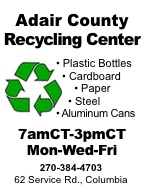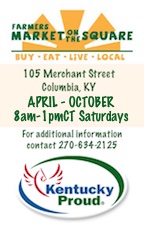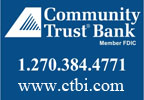| ||||||||||
Dr. Ronald P. Rogers CHIROPRACTOR Support for your body's natural healing capabilities 270-384-5554 Click here for details 


Columbia Gas Dept. GAS LEAK or GAS SMELL Contact Numbers 24 hrs/ 365 days 270-384-2006 or 9-1-1 Call before you dig Visit ColumbiaMagazine's Directory of Churches Addresses, times, phone numbers and more for churches in Adair County Find Great Stuff in ColumbiaMagazine's Classified Ads Antiques, Help Wanted, Autos, Real Estate, Legal Notices, More... 
|
Chuck Hinman, IJM 374: Wash Day A tradition for Chuck Hinman's mother was to get a head start on the week by starting clothes washing on Sunday Evenings Next earlier Chuck Hinman story, Picture It! Reader comments to CM are appreciated, as are emails directly to Mr. Hinman at: charles.hinman@sbcglobal.net by Chuck Hinman Wash Day "This is the day we wash our clothes, wash our clothes, wash our clothes. This is the day we wash our clothes, so early on Monday morning." Those are just part of the words from an old nursery rhyme entitled "Here We Go 'round the Mulberry Bush." They are like old friends to people who lived in the 1930's. The whole nursery rhyme chronicles the highlights of a housewife's weekly activities. The wording in the rest of this nursery rhyme goes -- "This is the day we iron our clothes" -- Tuesday; scrub the floor - Wednesday; mend our clothes -- Thursday; sweep the floor -- Friday; bake our bread -- Saturday; and -- go to church -- Sunday morning. My memory is that grandma and mom took their marching orders for their weekly activities from this well-known ditty. They stayed remarkably true to the exact order of the daily tasks. Consider how often you have seen a set of seven embroidered tea towels which portrayed the message of this nursery rhyme. It was so ingrained that my Mom, in anticipation of getting a head start on the week's activities, started the clothes washing on Sunday evening. I think there was a smidgen of pride in each housewife's mind to have her clothes on the line before her neighbors! And it was a definite mark of pride in each housewife to have the whitest tea towels flapping on the line in Gage County, Nebraska. The dingiest part of the laundry was relegated for drying on the fences out of the prying eyes of travelers along those country roads. During week, laundry accumulated in fruit baskets During the week, the dirty clothes were accumulated in several fruit baskets. It was the whole family's responsibility to put their dirty clothes in these baskets. Sunday evening, Mom sorted the dirty clothes into several piles, one for white and light colored clothes, one for bath towels, sheets and cases, colored things, overalls, and finally rags and the grimy- dingy- dirties! Before she went to bed, she retrieved from the pantry several bars of the lye soap she had made last winter and shaved each bar into thin slices ready for tomorrow. The soap had an acrid-clean smell to it but not a friendly smell -- more like it couldn't wait to bully the dirty-dirt and sweat out of the clothes. Kind of like it had a chip on its shoulder, know what I mean? Even though we had a house with the latest accommodations of the period, we did not have a hot-water tank large enough to do the Monday clothes washing. For that job we had a huge black iron kettle in the back yard which was also used when Mon made lye soap or rendered lard at butchering time. Brother Bob, author assigned job of filling iron kettle with water When Brother Bob and I got old enough, we were assigned the job of filling the iron kettle with water from the nearby hydrant on the backside of the house. When the kettle was filled we fetched a basket of cobs from the cob pile out by the granary and with the help of some well-placed kerosene, a roaring fire was soon licking the sides and bottom of the iron kettle. We tended the fire until the water was properly heated. When the water began to simmer, Mom came with a can of lye. She shook a little lye in the water. Our water was very hard and the purpose of the lye was to break the hard water. It caused the minerals to float to the top of the kettle where it had the appearance of a white scum. Then she skimmed this yucky looking scum off the top with a large coffee can and threw it on the ground. One time, our small white dog, Patty, was lying nearby and Mom without realizing it seared Patty's back with boiling lye water. This was a real tragedy and Mom was heartbroken. Patty was like one of her kids! Obviously the washing operation was shut down for a while as she administered First Aid and shed many tears. Patty lived a few months but eventually Dad had to put her down. It was now time to carry the hot water to the washing machine in the basement. The washing machine consisted of two wooden tubs with wooden dollies suspended from the lid. Each dolly had four wooden teats for grabbing and turning the clothes in the water. Mom had already dropped in her shaved laundry soap and the mixing action of the revolving dollies quickly made a bubbly soapy mixture to which she added the first pile of light clothes. The washing action was powered by a big old motor nearby that with a maze of overhead belts and pulleys caused the wooden dollies on the washing machine to turn in an early-day washing machine. In addition to the wooden tubs for the washing process, Mom had a large galvanized tub with cold water to which she added a small portion of Stewart's bluing. A dash of this bluing made the white clothes whiter and didn't have much affect on colored clothes. There was a clothes ringer on the side of the wooden washtubs, which rung the water out of the clothes. After washing, clothes hung on clothesline to dry After all the clothes were washed they were moved out to the clothesline and hung to dry with wooden clothespins. Mom was very careful to hang the clothes so they dried with the least amount of wrinkling. This was before the days of "wash-n-wear" clothes. She carefully hung in groups -- tea towels, bath towels, sheets, etc. I remember as an ornery little boy being awed by the spectacle of large cotton panties hanging side by side to dry. "Who in our family wears those?" Ysh! Things like overalls, blue chambray work shirts, throw rugs, cleaning rags, and yes, even the rag mop, etc., were the last things washed, then hung on the garden fence out of the sight of travelers on the road. They only got to see what Mom let them see and that did NOT include her bloomers! Disposing of wash water was yet another task There was still the job of disposing of gallons of wash and rinse water. If there was a porch or sidewalk that would benefit from cleaning with warm, soapy water, then that was done with an old broom, otherwise all the water was drained on to the basement floor where it found its way to a floor drain. The tubs were rinsed out and allowed to dry the rest of the day. Later in the afternoon Mom brought the clothes in off the line and folded and sprinkled them for ironing -- but not today. Today -- Monday was "the day we washed our clothes, washed our clothes, washed...." Chuck Hinman, former Nebraska farm boy, spent his working days with Phillips Petroleum Company in Bartlesville, Oklahoma, and Houston, Texas. He lives at Tallgrass Estates in Bartlesville where he keeps busy writing his memories. His hobbies are writing, playing the organ, and playing bridge. This story was posted on 2009-09-13 07:40:21
Printable: this page is now automatically formatted for printing.
Have comments or corrections for this story? Use our contact form and let us know. More articles from topic Chuck Hinman - Reminiscences:
Chuck Hinman IJM No. 306: Chuck Hinman IJMA No. 172: Depression Days Chuck Hinman, IJMA #10, My Dad, Arley Hinman Chuck Hinman: IJMA #176 Not in my boat Chuck Hinman: IJM # 353 Mom's Aprons Chuck Hinman, IJMA #149: Half-soles. Remember them? Chuck Hinman IJMA #180: Get a Life! Chuck Hinman IJMA #146: It's a Jungle out There Chuck Hinman IJMA #183: Shoo Fly! Chuck Hinman #034 : Home, sweet home, circa 1929 View even more articles in topic Chuck Hinman - Reminiscences |



|
||||||||
|
| ||||||||||
|
Quick Links to Popular Features
Looking for a story or picture? Try our Photo Archive or our Stories Archive for all the information that's appeared on ColumbiaMagazine.com. | ||||||||||
|
Contact us: Columbia Magazine and columbiamagazine.com are published by Linda Waggener and Pen Waggener, PO Box 906, Columbia, KY 42728. Please use our contact page, or send questions about technical issues with this site to webmaster@columbiamagazine.com. All logos and trademarks used on this site are property of their respective owners. All comments remain the property and responsibility of their posters, all articles and photos remain the property of their creators, and all the rest is copyright 1995-Present by Columbia Magazine. Privacy policy: use of this site requires no sharing of information. Voluntarily shared information may be published and made available to the public on this site and/or stored electronically. Anonymous submissions will be subject to additional verification. Cookies are not required to use our site. However, if you have cookies enabled in your web browser, some of our advertisers may use cookies for interest-based advertising across multiple domains. For more information about third-party advertising, visit the NAI web privacy site.
| ||||||||||



















































